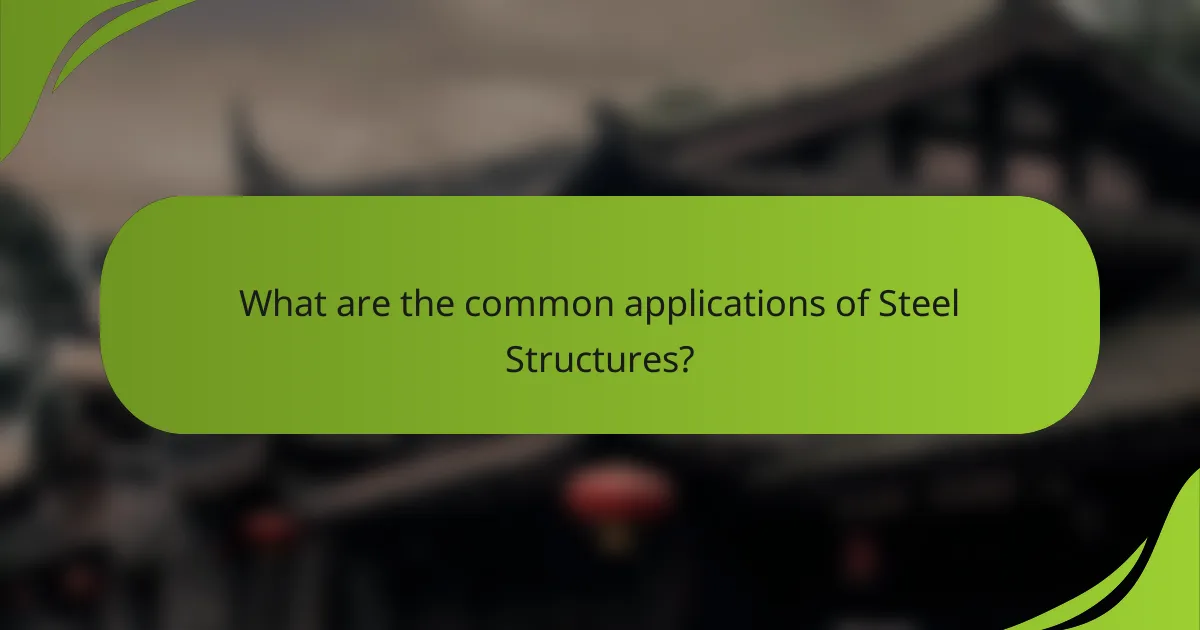Steel structures are buildings or frameworks primarily constructed from steel, recognized for their strength, durability, and ability to support heavy loads while resisting environmental factors. These structures are widely used in various applications, including bridges, skyscrapers, industrial buildings, and stadiums, due to their design flexibility and lightweight nature, which allows for large spans and open spaces. The high strength-to-weight ratio of steel facilitates efficient construction methods and supports modifications, leading to potential cost savings in materials and labor. Additionally, steel’s recyclability enhances its sustainability, making it a preferred choice in modern architecture and construction practices.

What are Steel Structures?
Steel structures are buildings or frameworks made primarily from steel. They are known for their strength and durability. Steel structures can support heavy loads and resist environmental factors. Common applications include bridges, skyscrapers, and industrial buildings. The use of steel allows for flexible design and construction methods. Steel’s recyclability contributes to sustainable building practices. According to the American Institute of Steel Construction, steel is one of the most recycled materials globally, enhancing its environmental benefits.
How are Steel Structures constructed?
Steel structures are constructed using a systematic process involving several key steps. First, the design phase includes creating detailed blueprints and specifications. Next, steel is fabricated in a factory, where it is cut, shaped, and assembled into components. These components are then transported to the construction site.
At the site, the foundation is prepared to support the steel structure. Steel components are erected using cranes and secured with bolts or welds. Once the frame is in place, additional elements like floors, walls, and roofs are added. Finally, inspections ensure that the structure meets safety and design standards.
This methodical approach allows for efficiency and precision in construction, contributing to the durability and strength of steel structures.
What materials are commonly used in Steel Structures?
Steel structures commonly use materials such as structural steel, concrete, and steel reinforcement bars. Structural steel is the primary material due to its high strength-to-weight ratio. It provides durability and can withstand heavy loads. Concrete is often used in combination with steel for foundations and floor slabs. Steel reinforcement bars, or rebar, enhance the tensile strength of concrete elements. Other materials include steel plates and sections, which are fabricated into beams and columns. These materials collectively contribute to the structural integrity and longevity of steel buildings.
What are the key design considerations for Steel Structures?
Key design considerations for steel structures include load capacity, stability, and material properties. Load capacity ensures the structure can support anticipated loads, including dead loads and live loads. Stability involves the structure’s ability to withstand lateral forces, such as wind or seismic activity. Material properties, including yield strength and ductility, affect performance under stress. Connections between steel members must be designed for strength and rigidity. Additionally, design must consider corrosion resistance and fire protection measures. Compliance with building codes and standards is essential for safety and durability. These factors collectively ensure the structural integrity and longevity of steel constructions.
What are the advantages of Steel Structures?
Steel structures offer numerous advantages. They provide high strength-to-weight ratios, making them ideal for large spans. Steel is also durable and resistant to weather, pests, and fire. This material allows for design flexibility, accommodating various architectural styles. Additionally, steel structures can be prefabricated, which speeds up construction time. They are recyclable, contributing to sustainability. Furthermore, steel requires less maintenance compared to other materials, reducing long-term costs. These benefits make steel a preferred choice in modern construction projects.
How does durability impact the use of Steel Structures?
Durability significantly enhances the use of steel structures. Steel’s resistance to corrosion and fatigue extends the lifespan of buildings. This longevity reduces the need for frequent repairs and replacements. According to the American Institute of Steel Construction, steel structures can last over 50 years with proper maintenance. The durability of steel also allows for the construction of taller and more complex designs. Stronger steel can support greater loads, facilitating innovative architectural solutions. Additionally, durable steel structures perform well under various environmental conditions. This reliability contributes to lower lifecycle costs, making steel a cost-effective choice.
What role does sustainability play in the advantages of Steel Structures?
Sustainability significantly enhances the advantages of steel structures. Steel is highly recyclable, with up to 90% of its material being reused in new construction. This reduces the demand for virgin materials and minimizes environmental impact. Additionally, steel structures are energy-efficient, often requiring less energy for heating and cooling compared to other materials. The durability of steel contributes to longevity, reducing the need for frequent replacements. Steel’s strength allows for lighter structures, which can decrease the overall material used in construction. These factors collectively support sustainable building practices and contribute to a lower carbon footprint in the construction industry.

How does Design Flexibility apply to Steel Structures?
Design flexibility in steel structures allows for various architectural styles and configurations. This flexibility enables designers to create complex shapes and open spaces without compromising structural integrity. Steel’s high strength-to-weight ratio supports larger spans with fewer columns. It also accommodates modifications during and after construction, facilitating renovations or expansions. The adaptability of steel can lead to cost savings in both materials and labor. Additionally, steel structures can incorporate sustainable design elements, enhancing their overall efficiency. This adaptability has been proven in numerous projects, demonstrating the material’s versatility and effectiveness in modern architecture.
What design options are available with Steel Structures?
Steel structures offer various design options, including modular, pre-engineered, and custom designs. Modular designs allow for prefabricated sections that can be easily assembled on-site. Pre-engineered buildings are designed for specific applications, optimizing material use and reducing costs. Custom designs cater to unique architectural requirements, providing flexibility in aesthetics and functionality. Additionally, steel’s strength enables long spans without support columns, enhancing open interior spaces. These design options contribute to efficient construction timelines and adaptability for future modifications.
How does modular design enhance flexibility in Steel Structures?
Modular design enhances flexibility in steel structures by allowing for easy reconfiguration and expansion. This approach utilizes standardized components that can be assembled in various configurations. As a result, modifications can be made without extensive redesign or reconstruction. Modular systems enable quick adaptation to changing needs, such as increased space requirements. They also facilitate efficient construction processes, reducing time and labor costs. Additionally, modular design supports sustainable practices by minimizing waste through optimized material use. Studies show that modular construction can decrease project timelines by up to 30%. This efficiency further contributes to the overall flexibility of steel structures.
What are the implications of customization in Steel Structures?
Customization in steel structures allows for tailored designs that meet specific project requirements. It enhances structural performance and aesthetic appeal. Customization can lead to improved load-bearing capacity and reduced material waste. Additionally, it enables integration of advanced technologies and materials. Customized designs can also optimize construction timelines and costs. According to the American Institute of Steel Construction, customized steel solutions can lead to up to 20% savings in overall project costs. Furthermore, customization supports sustainability by allowing for the use of recycled materials and efficient design practices.
Why is Cost Efficiency important in Steel Structures?
Cost efficiency is crucial in steel structures because it significantly reduces overall project expenses. Efficient use of materials leads to lower costs in procurement and construction. Steel’s strength-to-weight ratio allows for lighter structures, which reduces foundation requirements. This results in savings on labor and material costs during installation. Additionally, cost-efficient designs can shorten construction timelines, further minimizing labor costs. According to the American Institute of Steel Construction, using steel can save up to 20% in overall project costs compared to other materials. Therefore, prioritizing cost efficiency in steel structures leads to substantial financial benefits for projects.
How do initial costs compare to long-term savings in Steel Structures?
Initial costs for steel structures are typically higher than for traditional building materials. However, long-term savings often outweigh these initial expenses. Steel structures offer durability, which reduces maintenance costs over time. They also provide energy efficiency, leading to lower utility bills. The lifespan of steel buildings can exceed 50 years, offering significant return on investment. According to the American Institute of Steel Construction, steel’s recyclability further enhances its economic benefits. In many cases, the total cost of ownership for steel structures is lower than for alternatives.
What factors contribute to the cost-effectiveness of Steel Structures?
The cost-effectiveness of steel structures is influenced by several key factors. First, steel has a high strength-to-weight ratio, which reduces material costs. This allows for lighter structures that require less foundation support. Second, steel structures can be prefabricated, leading to faster assembly on-site. This reduces labor costs and construction time. Third, steel is durable and requires less maintenance over time, lowering long-term costs. Additionally, steel’s recyclability contributes to sustainability and potential cost savings. Finally, advancements in technology have improved steel production efficiency, further enhancing its cost-effectiveness.

What are the common applications of Steel Structures?
Steel structures are commonly used in various applications, including commercial buildings, industrial facilities, bridges, and warehouses. They provide durability and strength, making them ideal for high-rise buildings. Steel’s lightweight nature allows for easier transportation and assembly on-site. Additionally, steel structures are often utilized in stadiums and arenas due to their ability to span large distances without the need for many supports. The construction industry frequently employs steel for its cost-effectiveness and design flexibility. According to the American Institute of Steel Construction, steel is the most recycled material in the world, highlighting its sustainability in construction.
In which industries are Steel Structures most commonly used?
Steel structures are most commonly used in the construction, automotive, aerospace, and energy industries. In construction, they provide frameworks for buildings and bridges. The automotive industry utilizes steel for vehicle manufacturing. Aerospace relies on steel for structural components in aircraft. The energy sector employs steel in the construction of power plants and wind turbines. These industries leverage steel’s strength and durability.
How do Steel Structures benefit commercial construction?
Steel structures provide significant benefits to commercial construction. They offer high strength-to-weight ratios, allowing for larger spans and open spaces. This flexibility in design enables architects to create innovative building layouts. Steel is also highly durable, resisting corrosion and weather damage. This longevity reduces maintenance costs over time. Additionally, steel structures can be prefabricated off-site, speeding up construction timelines. According to the American Institute of Steel Construction, steel buildings can be erected faster than those made from other materials. This efficiency can lead to lower overall project costs.
What role do Steel Structures play in infrastructure projects?
Steel structures serve as the backbone of infrastructure projects. They provide strength, durability, and flexibility in design. Steel’s high tensile strength allows for the construction of taller and more complex structures. This material can withstand extreme weather conditions and seismic activities. Steel structures are also cost-effective due to their recyclability and lower maintenance needs. According to the American Institute of Steel Construction, steel is 100% recyclable, which reduces waste and environmental impact. Additionally, steel’s lightweight nature simplifies transportation and installation processes. Overall, steel structures enhance the efficiency and longevity of infrastructure projects.
What best practices should be followed when using Steel Structures?
Use high-quality steel materials to ensure structural integrity. Proper material selection enhances durability and safety. Implement accurate design calculations to optimize load-bearing capacity. This minimizes the risk of structural failure. Follow industry standards for fabrication and assembly. Adhering to standards ensures compliance and safety. Conduct regular inspections and maintenance to identify wear or damage. This prolongs the lifespan of the structure. Utilize corrosion protection methods, such as galvanization or coatings. This prevents deterioration over time. Engage qualified professionals for design and construction. Expertise leads to better outcomes and compliance with regulations.
How can maintenance enhance the lifespan of Steel Structures?
Maintenance enhances the lifespan of steel structures by preventing corrosion and structural degradation. Regular inspections identify potential issues early. Timely repairs address wear and tear effectively. Protective coatings can be reapplied to shield against environmental factors. Cleaning removes contaminants that may cause rust. Scheduled maintenance reduces the likelihood of major failures. Studies show that well-maintained steel structures can last significantly longer than neglected ones. For example, routine maintenance can extend the lifespan by 20% to 30%.
What safety standards must be adhered to in Steel Structure design?
Safety standards in steel structure design include the American Institute of Steel Construction (AISC) standards, which provide guidelines for structural integrity. The International Building Code (IBC) also sets forth requirements for safety and performance. Additionally, the American Society for Testing and Materials (ASTM) standards ensure material quality and performance. Compliance with these standards helps prevent structural failures and ensures safety during construction and occupancy. Regular inspections and adherence to these codes are critical for maintaining structural safety throughout the lifespan of the steel structure.
Steel structures are frameworks primarily composed of steel, recognized for their strength, durability, and flexibility in design. This article provides an overview of the construction process, materials used, and key design considerations that contribute to their structural integrity and longevity. It highlights the advantages of steel structures, including cost efficiency, sustainability, and design flexibility, while also discussing their common applications across various industries. Additionally, best practices for maintenance and adherence to safety standards are addressed, underscoring the importance of proper care in extending the lifespan of steel constructions.